Further Holdouts and Surrenders
The logical demands of the surrender were formidable. So many different ceremonies took place across Asia and the entire Pacific. Here we will some that preceded peacefully and others that refused the peace. In actuality, the state of war between the U.S. and Japan did not officially end until the Treaty of San Francisco took effect 28 April, 1952.
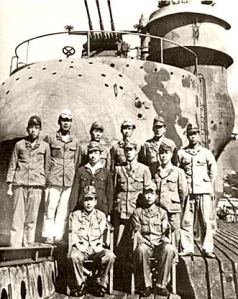
USS Segundo SS-398 located this Japanese sub 1-401 and negotiated with the crew being that their captain had committed suicide
One mass surrender did occur at Noemfoor in September 1944 when 265 Japanese enlisted men, angry at their superiors for stealing their food for their own use. And, in August 1945, another starving Japanese military unit surrendered to a lieutenant in New Guinea. On 1 December 1945, Captain Oba and 46 members of his unit were the last Japanese on Guam to surrender.
In 1946, on Lubang Island, Philippines, intense fighting developed on 22 February when American and Filipino troops met 30 Japanese soldiers. Eight of the Allied troops were killed. Then in April, 41 members of a Japanese garrison came out of the jungle, unaware that the war was over.
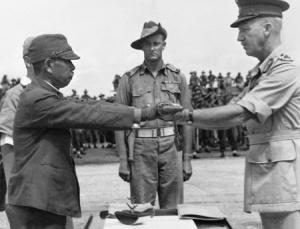
Australian 6th Div. MGen. Robertson and interpreter explain terms of surrender to Adm. Sata aboard ML-805 (patrol boat) in Kairiru Strait
At the end of March 1947, a band of Japanese led by Ei Yamaguchi of 33 men renewed the fighting on Peleliu Island. There were only 150 Marines stationed on the island by that time and reinforcements were called in to assist. A Japanese Admiral also went to convince the troops that the war was indeed over. The holdouts came out of the jungle in two different groups in late April. Yamaguchi returned to his old tunnel in 1994 and Eric Mailander and Col. Joe Alexander interviewed him. To see the interview go to – http://www.pacificwrecks.com/people/visitors/mailander/ (If this link was not done correctly, please go to Pacific Wrecks. com)
In that same month, on Palawan Island, 7 Japanese troops armed with a mortar launcher emerged from the jungle and surrendered. On 27 October 1947, the last Japanese soldier surrendered carrying a water bottle, a broken Australian bayonet and a Japanese entrenching tool.
Not until late 1948, did 200 well organized troops give themselves up on Mindinao, P.I. And, in China, 10-20,000 well equipped Japanese troops who were trapped in the mountains of Manchuria between the warring Nationalist and Communist forces, finally found a chance to surrender.
In 1949, there was one report of two men living in the shadow of American troops finally turning themselves in.
One unusual story – On 3 January 1945, a B-29 Superfortress from the 498th Bomb Group, 875th Squadron, crashed while returning from a bombing mission. On 30 June 1951, men were sent to the area to try and recover the bodies of the plane’s crew. What they encountered were 30 Japanese who did not believe the war was over. They had had a Korean woman with them, but after she spotted an American vessel sailing by and was rescued, the information was received and interest in the “Robinson Crusoes of Anatahan Island” developed.
Teruo Nakamura was the last known holdout of WWII when he emerged from the jungle retreat that housed him in Indonesia, December 1974. There were rumors of men claiming to be holdouts later on, but none that were officially confirmed.
Posted on April 20, 2013, in Uncategorized, WWII and tagged family history, History, Japanese surrenders, Military, Military History, New Guinea, Pacific War, Philippines, veterans, WWII. Bookmark the permalink. 33 Comments.
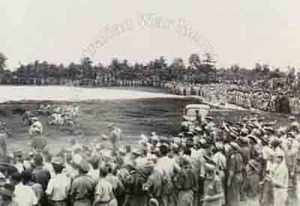
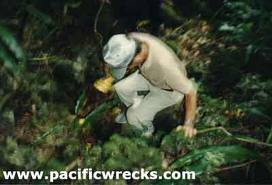
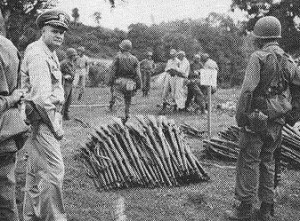
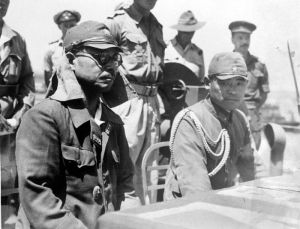







GP, thanks for sending me to this post. The Pacific theater was so vast and scattered that Japanese hiding in the jungle won’t know the war was over. Even with the pamphlets dropped at strategic points, those Japanese probably did not believe it.
LikeLiked by 1 person
You’re right. The Japanese soldiers would naturally assume the pamphlets were nothing but propaganda.
LikeLiked by 1 person
Mary, Don’s associate writing this – you might be interested in this story posted on Don’s website: http://donmooreswartales.com/2012/04/25/arthur-anderssen/ He was on Guam when the “last holdout” was discovered and I’ve provided a link to that particular news story.
Fine job you’ve done on this site.
LikeLike
I answered this on your site, but still wanted to thank you for your compliment and for reading.
LikeLike
I am not quite sure that I have ever read an article or history book that covered this topic. I was not a history major, but the interesting detail, and fluidly written post make me feel like a willing-student of history now. Thank you for this post, this blog and for sharing these valued memories.
LikeLike
Thank you very much for your comments, but I must clarify that these are the recollections of the troopers. I try to specify when they are my memories or feelings.
LikeLike
What an amazing blog site, thank you so much for taking the time to share all of knowledge and images. I wish you the very best in the future, keep up the good work.
LikeLike
Thanks for stopping in, I hope you’ll return. I hope I can continue for a while, even after Smitty’s story is finished.
LikeLike
Hi, minor edit there – Mindinao, P.I. should be Mindanao. Thanks.
LikeLike
Thanks, word-check wasn’t going to catch that one.
LikeLike
When one or two of the late surrenders made it back to their home town, at least found their wives had remarried. All had difficulty accepting the way things had become. Indeed, I did feel great sorrow for them.
You mention the large numbers returning from Manchuria. Some of that was made possible by MacArthur. This would also be in corroboration of my father saying he interrogated dozens returning from Manchuria in ’48 and ’49 as part of G-2.
Correct me if I’m wrong, but wasn’t Oba’s men “toukoutai”, or suicide troops dedicated to the name of the Emperor? Or was that somewhere else? Old age sucks. 🙂
LikeLike
I know what you mean about the old age. I did not see any mention of ‘toukoutai’, but that doesn’t mean it isn’t so.
LikeLike
Fascinating…a word that several other commenters also chose but it is so appropriate to this post!
LikeLike
Thanks. It was such a huge undertaking, I don’t know how they ever got it all done and everybody back home.
LikeLike
It goes to show what really can be accomplished if we work together…even if everything is FUBAR.
LikeLike
That’s true, wish we still did.
LikeLike
Fascinating. I suppose when one considers how long the war lasted, it is not surprising that it took a while to tie up all the loose ends.
LikeLike
The battle areas of the Pacific were scattered hundreds and thousands of miles apart; unlike Europe, where each country abuts the other. Glad you enjoyed reading.
LikeLike
Yes, it was a huge theatre of war.
LikeLike
Fascinating! I do remember hearing that story back in 74 about the last holdout. That was unbelievable.
LikeLike
Me as well. I guess I remember more history than I realize.
LikeLike
Thanks for the visit and the like of my post.
LikeLike
Certainly, it was entirely my pleasure.
LikeLike
Cool pics. Was that the Japanese sub that was also a aircraft carrier?
LikeLike
Not to my knowledge. Thanks for dropping in.
LikeLike
It doesn’t surprise me that there were so many who really didn’t know the war was over. It would have been easy to hide out in the thick jungles on all those small islands, with no contact from Japan, just staying and holding the ground they were on.
LikeLike
Yes, of what I understand, unless you’ve been in one of those jungles, you can not imagine how dense they are.
LikeLike
I did read before a number of the stories, as those were of interest to me. It seemed strange to me people would not know the war was over 20 years after it happened. One would assume they would at least try to make contact with someone.
But, regardless, interesting stories. I do remember that when some of those late hold-outs went back home, they were often treated with honor and respect.
LikeLike
Yes, I said that to Pierre Lagace as well, million of phamphlets were dropped announcing peace, but what are going to do? Especially the 1974 story, I remember when that happened. He was honored because of his loyalty.
LikeLike
I commented this morning.
Most interesting information.
LikeLike
Thank you.
LikeLike
A reblogué ceci sur Lest We Forget and commented:
Most interesting about Japanese soldiers surrendering late after the end of the war.
LikeLike
Millions of papers explaining the surrender were dropped everywhere, but some kept saying that they didn’t know about it. What can you do?
LikeLike